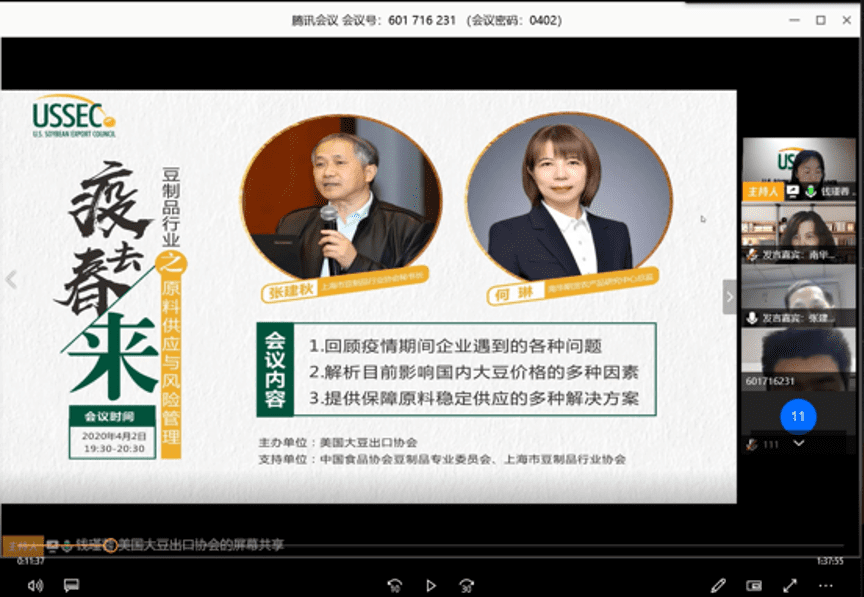Chinese Food Bean Customers Participate in USSEC Webinar
- Category:
- General News
- Soy Foods
- Virtual Events

On April 2, USSEC China organized a food bean webinar, “U.S. Soy Solutions for Specialty Soy Food Products and Purchasing Decision Recommendations for U.S. Soy Importers/Buyers.” The webinar is part of USSEC’s initiative to stay virtually connected with its customers during the COVID-19 pandemic. The Bean Produce Committee of the China Food Industry Association and the Shanghai Bean Products Association provided support for this invitation-only digital event, which had 63 total meeting participants, including 10 live attendees.


Joanna Qian, Human Utilization (HU) Program Manager, USSEC China, hosted the webinar and speakers included Mr. Jianqiu Zhang, Vice President/Secretary General, Shanghai Bean Products Association, and Ms. Lin He, Agricultural Research Center Director, Nanhua Futures Co., Ltd.
USSEC Chairman Monte Peterson and CEO Jim Sutter greeted participants via a video message.


Three main topics were introduced in the presentations, including a review of the raw material supply issue encountered by Chinese food processors during the COVID-19 pandemic, the analysis of various factors affecting domestic soybean prices, and providing solutions to ensure the stable supply of raw materials.
The review of the raw material supply issue took an in-depth look at how the transportation of China domestic soybeans was blocked due to COVID-19 road closures in February. Additionally, China’s soybean No.1 futures price has risen continuously from December 2019 to now.


For the analysis of various factors affecting Chinese domestic soybean prices, several components were examined, including the waterlogging disaster in Heilongjiang Province from July to August of 2019, which resulted in soybean yields decreasing by 20 to 30%; the modification of DCE contract delivery standards; COVID-19; and the increase of SINOGRAIN soybean reserve price.
For the third topic, providing solutions to ensure the stable supply of raw materials, several recommendations were made. They included learning more about the U.S. soybean market to develop a new supply channel; choosing a stable supplier, ensuring supply by advance contracting, especially for IP food beans; and hedging with futures.


Participants were able to interact through comments and asking questions.

Ms. Qian informed participants that Chinese soybean importers can apply for tariff exclusion. If approved by the Ministry of Finance, the importer can still enjoy a general 3% tariff, which is an outcome of the Phase I trade agreement. The exclusion system started to accept applications on March 2. Finally, Ms. Qian reinforced to webinar attendees that the USSEC teams continues to work diligently to update the status of the U.S. soy market and the supply chain and will continue to organize a series of virtual meetings.